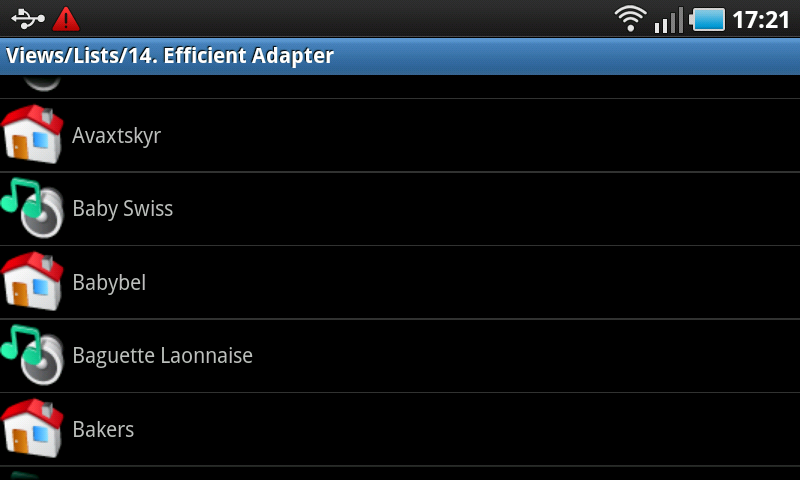自定义ArrayAdapter 自定义格式
private static class EfficientAdapter extends BaseAdapter {
private LayoutInflater mInflater;
private Bitmap mIcon1;
private Bitmap mIcon2;
public EfficientAdapter(Context context) {
// Cache the LayoutInflate to avoid asking for a new one each time.
mInflater = LayoutInflater.from(context);
// Icons bound to the rows.
mIcon1 = BitmapFactory.decodeResource(context.getResources(), R.drawable.icon48x48_1);
mIcon2 = BitmapFactory.decodeResource(context.getResources(), R.drawable.icon48x48_2);
}
/**
* The number of items in the list is determined by the number of speeches
* in our array.
*
* @see android.widget.ListAdapter#getCount()
*/
public int getCount() {
return DATA.length;
}
/**
* Since the data comes from an array, just returning the index is
* sufficent to get at the data. If we were using a more complex data
* structure, we would return whatever object represents one row in the
* list.
*
* @see android.widget.ListAdapter#getItem(int)
*/
public Object getItem(int position) {
return position;
}
/**
* Use the array index as a unique id.
*
* @see android.widget.ListAdapter#getItemId(int)
*/
public long getItemId(int position) {
return position;
}
/**
* Make a view to hold each row.
*
* @see android.widget.ListAdapter#getView(int, android.view.View,
* android.view.ViewGroup)
*/
public View getView(int position, View convertView, ViewGroup parent) {
// A ViewHolder keeps references to children views to avoid unneccessary calls
// to findViewById() on each row.
ViewHolder holder;
// When convertView is not null, we can reuse it directly, there is no need
// to reinflate it. We only inflate a new View when the convertView supplied
// by ListView is null.
if (convertView == null) {
convertView = mInflater.inflate(R.layout.list_item_icon_text, null);
// Creates a ViewHolder and store references to the two children views
// we want to bind data to.
holder = new ViewHolder();
holder.text = (TextView) convertView.findViewById(R.id.text);
holder.icon = (ImageView) convertView.findViewById(R.id.icon);
convertView.setTag(holder);
} else {
// Get the ViewHolder back to get fast access to the TextView
// and the ImageView.
holder = (ViewHolder) convertView.getTag();
}
// Bind the data efficiently with the holder.
holder.text.setText(DATA[position]);
holder.icon.setImageBitmap((position & 1) == 1 ? mIcon1 : mIcon2);
return convertView;
}
static class ViewHolder {
TextView text;
ImageView icon;
}
}

EG

分享到:












相关推荐
在Android开发领域,Apidemo是一个非常重要的学习资源,它包含了大量的示例代码,帮助开发者深入理解Android API的各种功能和用法。标题“学习Android Apidemo从这开始”表明我们将从基础开始,逐步深入地探索这个...
android ApiDemo android ApiDemo
通过深入研究Android ApiDemo,开发者不仅可以理解Android API的工作原理,还能学习到最佳实践,这对于构建高质量的Android应用程序至关重要。对于初学者来说,这是一个非常宝贵的教育资源,可以帮助他们快速掌握...
在Android开发领域,API Demo是学习和理解Android SDK核心功能的重要资源。这个详尽的指南专为初学者设计,旨在帮助你快速掌握Android开发的基本概念和实践技巧。 1. **创建ApiDemo示例**: 在Android开发中,...
android apidemo.apk
总的来说,Android 5.0 ApiDemo是一个宝贵的资源,对于想要学习和掌握Android 5.0新特性的开发者来说,它提供了一个实践和学习的平台,同时也帮助开发者更好地适配和优化在Android 5.0系统上的应用。
Android官方ApiDemo是Android开发者学习和掌握Android API的重要资源,它包含了Android系统各种API的功能示例,涵盖了从基础到高级的各种功能,为开发者提供了直观的代码实例。这个项目可以直接在Android Studio中...
"学习android 的sample apidemo"这个项目提供了一系列实例,旨在帮助开发者更好地理解和应用Android SDK中的各种API。这些示例覆盖了从基本的UI组件到复杂的网络通信、多媒体处理等各个方面,是初学者入门和资深...
通过深入学习和实践这些示例,开发者可以更好地理解和掌握 Android 平台的开发技巧。 1. **API 级别 17**:这是针对 Android 4.2 (Jelly Bean) 版本的 API,包含了该版本中的新特性和更新的 API。例如,Android 4.2...
首先,我们要明白,Android 1.5 ApiDemo是一个包含所有1.5版本API源码的示例集合,它是开发者学习和理解Android API功能的最佳实践资源。通过ApiDemo,我们可以看到每一个API的实际应用场景,有助于我们快速上手并...
总之,`Android 示例源码 Apidemo` 是一个强大的学习工具,无论你是初学者还是经验丰富的开发者,都能从中受益匪浅。通过深入研究和实践,你可以提升自己的 Android 开发技能,并更好地应对实际项目中的挑战。
Android ApiDemo是Android开发中的一个重要学习资源,它包含了大量的示例代码,涵盖了Android SDK的各种API功能,对于开发者来说,这是一个不可多得的学习和参考工具。本篇文章将深入探讨ApiDemo中的核心知识点,并...
在创建ApiDemo示例中,开发者能够学习如何设置应用的基本框架,并了解如何在项目中集成不同的示例模块。 2. 示例解析(2): SimpleAdapter, ListActivity, PackageManager 在这一部分,会涉及到如何使用SimpleAdapter...
Google官方ApiDemo源码是学习和探索Android平台API功能的宝贵资源,尤其对于开发者来说,这是一个了解和实践最新API用法的实用工具。这个源码包基于Android 4.4(KitKat)版本,意味着它包含了自Android API Level ...
在Android开发领域,ApiDemo是一个不可或缺的学习资源,它为开发者提供了大量示例代码,帮助我们更好地理解和运用Android SDK中的各种API。"android samples 导入可以运行查看"这句话揭示了ApiDemo的核心价值——它...
通过学习和理解ApiDemo,开发者可以更好地理解和运用Android系统的各项功能。 1. **Android SDK和API Level 10** Android SDK(Software Development Kit)是开发Android应用的基础工具集,包含了编译、调试、...
ApiDemo1.6是一个非常有价值的软件开发学习资源,尤其对于初学者和有经验的开发者来说,它都具有很高的参考价值。"ApiDemo"这个标签表明这是一个专注于API(应用程序接口)实践的应用示例集合,旨在帮助我们理解并...
【ApiDemo】是一款针对Android平台的应用程序,它集成了各种API的示例代码,帮助开发者理解和学习如何在实际项目中使用这些API。最新版本的ApiDemo对应的是Android 6.0(API级别23),这是一个重要的里程碑,因为它...
如果ApiDemo包含这部分,开发者可以学习到如何创建自定义ContentProvider和如何与其他应用共享数据。 6. **Service**:服务(Service)用于在后台执行长时间运行的任务,不受用户界面的影响。ApiDemo可能展示如何...
开发者可以从中学习如何编写高效的代码并提高应用的整体性能。 **10. 兼容性与版本适配** 随着Android版本的不断更新,兼容性问题日益突出。ApiDemo 展示了如何使用Support Library 和 AndroidX 来确保应用在不同...